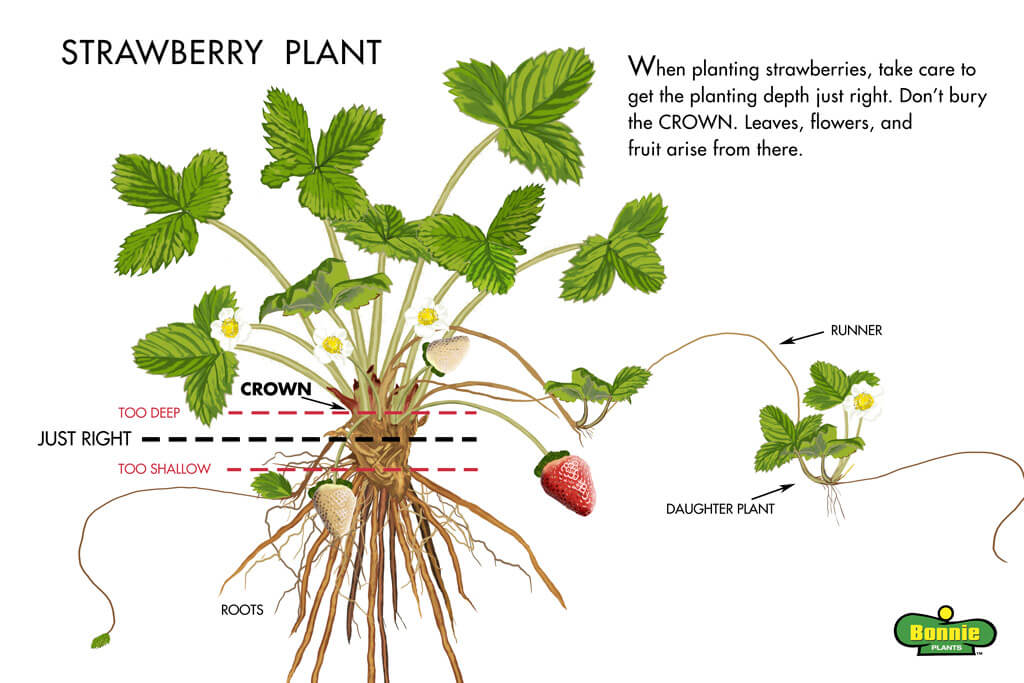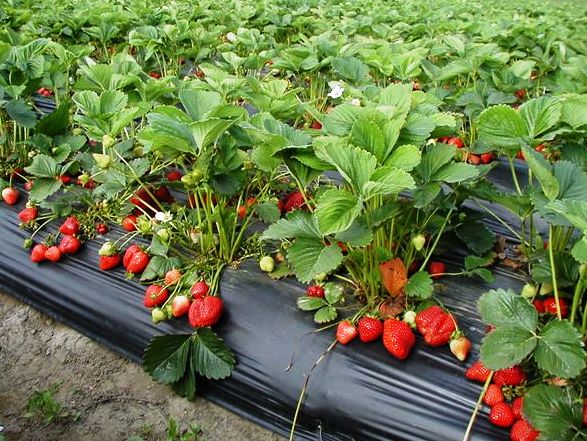Growing Strawberries
The best strawberries you’ll ever taste will come from a garden. Get expert tips on growing delicious strawberries at home.
&body=Check out Growing Strawberries at Bonnie Plants https://bonnieplants.com/blogs/how-to-grow/growing-strawberries” target=”_blank” rel=”noreferrer noopener”>


The best strawberries you’ll ever taste will come from a garden, because fully ripened strawberries have a rich, aromatic flavour unmatched by their supermarket counterparts. Savoring the melt-in-your-mouth juiciness of freshly picked strawberries is but one reason to grow your own. As the first fruits to ripen in spring, strawberries are nutritious assets to any garden.
The sturdy little plants prosper when planted in properly prepared beds or rows, or you can put them to work as edible edgings or let them sprawl over the top of a wall. Strawberries are happy to grow in strawberry jars and hanging baskets, too. For the very best results no matter where you plant them, start with vigorous young Bonnie Plants® strawberry plants. Bonnie has been helping home gardeners grow better for over a century, so you can rely on us.
Quick Guide to Growing Strawberries
- Plant strawberries in spring or fall based on your growing zone. In-ground gardens, raised beds, and containers are all excellent growing areas.
- Give strawberries room for runners by planting them 18 inches apart. Strawberries can be grown in a variety of ways, but make sure they get 8 or more hours of sun and are planted in slightly acidic soil with a pH of 5.5 to 6.8.
- Give your native soil a boost by mixing in several inches of aged compost or other rich organic matter. Consider a premium bagged potting mix for growing in containers.
- Give plants 1 to 1.5 inches of water weekly, and avoid wetting the leaves.
- Promote excellent fruit production by keeping plants fed with a continuous-release fertilizer.
- Harvest ripe strawberries in the cool of morning and refrigerate them right away.
The Strawberry Life Cycle
Success with strawberries asks that you understand their life cycle. Like most hardy perennials, strawberries die back in winter and start growing vigorously as the soil warms in spring. After bearing fruit (as early as February in Florida, or June farther north), many types of strawberries produce numerous runners with baby plants at the tips. Those runners often root themselves nearby yet remain attached to the mother plant. These types of strawberries produce more fruit if you clip off most of the runners, allowing each plant to produce no more than 3 daughter plants each summer. (Some varieties of strawberries produce few to no runners.)
Exhausted from producing fruit and offspring, strawberries typically take a second rest period during summer’s second half. When kept weeded and lightly watered, most parent plants – and their offspring – perk up and grow again for a while in the fall. Even though it may look like little is going on with strawberries in September, the plants are busy during the fall months developing the latent buds that will grow into next spring’s flowers.
From zone 6 northward, strawberries are best planted in spring so they will be well-rooted by the following winter. Containers can be replanted in late summer and moved to a cool, protected place such as an unheated garage during the coldest months.
From zone 7 southward, strawberries can be planted in fall. (In Florida and other warm, humid coastal areas, many are grown as cool weather annuals.) Once a planting is established, simply lift your healthiest plants each September, and replant them in a freshly renovated site.
Growing strawberries doesn’t have to entail so much work, though. In all areas, strawberries can be allowed to grow into a vibrant green ground cover that requires little maintenance. The plants won’t bear as heavily as more intensively managed plants, but they will still produce delicious berries, year after year.
Soil, Planting, and Care
Strawberries need at least 8 hours of full sun each day, and they prefer slightly acidic soil with a pH between 5.5 and 6.8. If soils in your area are naturally alkaline, it is best to grow strawberries in half-barrels or other large containers filled with premium quality potting soil, like aged compost-enriched Miracle-Gro® Performance Organics® All Purpose Container Mix. Strawberries may also sulk in heavy clay, which should be generously amended with composted leaves, fully rotted sawdust, or Miracle-Gro® Performance Organics® All Purpose In-Ground Soil—like the Container Mix, it contains high-quality aged compost—before planting strawberries. After mixing in 4 inches or more of compost, rake clay soil into raised mounds to further improve drainage. If your soil is sandy, simply cultivate to remove weeds, and mix in a 1-inch layer of rich compost or rotted manure.
Many varieties of strawberries eagerly produce offspring, so it is best to space them 18 inches apart. There are a few varieties, though, that produce few if any runners; these can be spaced 6 inches apart. (Check the plant tag for exact details on spacing.) Be sure to set the plants so that their roots are well covered with soil but the central growing bud, or crown, is exposed to light and fresh air. This is very important: If you bury the crown, the plant could easily rot. Water them well. Any type of mulch – from black plastic to pine straw to shredded leaves – will keep the soil moist and the plants clean. Fertilize with Miracle-Gro® Performance Organics® Edibles Plant Nutrition Granules for excellent results. This plant food works in tandem with great soil to provide just the right environment and nutrition for strong growth. Look for your plants to begin blooming in early spring, and the flowers must be visited by bees and other pollinating insects before they can set fruit. In warm, sunny weather, berries ripen about 30 days after blossoms are fertilized.
June-bearing varieties such as Allstar bear all at once, usually over a period of about 3 weeks. Although called June-bearing, these bear earlier than June in warm climates.
Everbearing varieties like Quinault produce a big crop from spring flowers, set light flushes of fruit through summer, and then bloom and bear again in late summer and fall.
Day-neutral varieties produce fruit continually throughout the season, until the first frost. They are not sensitive to variations in the amount of daylight like other types of strawberries are.
Troubleshooting
Slugs often chew holes in strawberries just as they begin to ripen. Organic mulches such as straw encourage slugs, so where slugs are a problem, a plastic mulch helps.
In summer, several fungal diseases cause dark spots to form on leaves. Clipping or mowing strawberry foliage and raking it away in summer can interrupt the life cycles of some strawberry pests and diseases. By far the worst pests of strawberries are birds. To keep robins, brown thrashers, and other fruit-eaters from stealing your berries, cover the plants with lightweight bird netting when the berries begin to ripen.
Sometimes your fruit may be small because of heat and drought. Once you start watering and the weather improves, the new fruit should be of normal size.
Harvest and Storage
Pick strawberries in the morning, when the fruits are cool, and immediately put them in the refrigerator. Wait until just before you eat or cook them to rinse the berries thoroughly with cool water. Extra strawberries can be frozen, dried, or made into jam or preserves.

It takes about a month to go from pollinated bloom to ripe fruit. 
Mulch, such as straw (as pictured here) or black plastic, helps keep the soil moist and the fruit clean. 
These young strawberry plants are sending out runners (the shoots to the left). You should clip most runners to allow the mother plant to produce more fruit. 
An arch made of wire fencing can support a row cover for frost protection in the spring and bird netting later when the fruit comes along. Remove row covers when possible to encourage visits by bees that help with pollination. 
If your strawberry plant produce deformed berries, the weather may be to blame. Bees tend to stay in their hives during rain and cool temperatures, which can hinder pollination. www.https://bonnieplants.com
